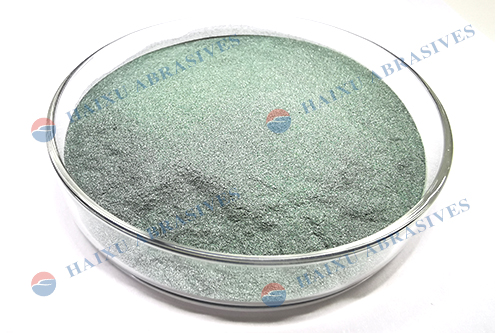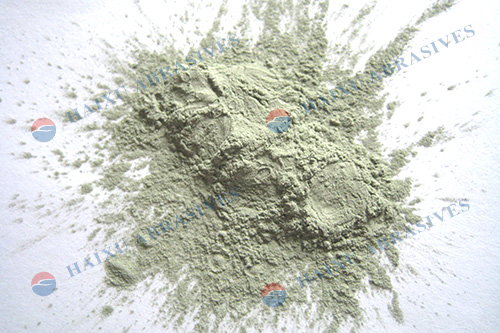Green silicon carbide JIS#280
Green silicon carbide JIS#280
Green silicon carbide JIS#280 is a very hard abrasive material with uniform particle size distribution. The hardness of it only ranks after diamond and B4C, and it is harder than black silicon carbide. So it is suitable for grinding a large range of hard materials such as titanium alloy, marble, carbide alloy, optical glasses, ceramics, etc.
On the other hand, green silicon carbide has extraordinary features such as high chemical stability, low thermal expansion rate, it is suitable for heat resistance & corrosion resistance coatings, paints, and other construction products.
Typical physical properties of Green silicon carbide JIS#280
| Mohs Hardness: | 9.5 |
| Vickers Hardness: | 3100-3400kg/mm2 |
| Specific Gravity: | 3.2g/cm3 |
| Bulk density(LPD): | 1.2-1.6 g/cm3 |
| Color: | Green |
| Particle shape: | Hexagonal |
| Melting Point: | Dissociated at about 2600 centigrade |
| Maximum service temperature: | 1900 centigrade |
| Friability | Friable |
| Thermal conductivity | 0.013 cal/cm2.sec (900°C) |
| Thermal expansion coefficient | 7-9 x10-6 /℃(0-1600°C) |
Chemical analysis of Green silicon carbide JIS#280
| Chemical Content | F20-F220 | F230-F2000 |
| SiC | Min 99% | Min 98.5% |
| SiO2 | Max 0.50% | Max 0.70% |
| F,Si | Max 0.20% | Max 0.40% |
| Fe2O3 | Max 0.10% | Max 0.15% |
| F.C | Max 0.20% | Max 0.30% |
| L.O.I | Max 0.05% | Max 0.09% |
Green silicon carbide JIS#280 particle size:
| Grit Size | D10(um) | D50(um) | D90(um) | D97(um) |
| JIS#280 | 42.151 | 65.467 | 97.248 | 97.248 |
Product Feature of Green silicon carbide JIS#280
- Extremely high hardness (Mohs 9.5, Vickers 3100-3400kg/mm2) with high wear-resistance ability. The hardness of SiC decrease with the increase of temperature. But still, even at the temperature of 1200°C, the hardness of green SiC is about twice that of fused alumina’s.
- Excellent chemical resistance and oxidation resistance. When heated at high temperatures, silicon carbide only oxidizes on the surface, forming a silicon dioxide film. The film can protect the silicon carbide material from oxidation. As a result, even at 1600°C, green SiC can maintain stability to most strong acids and alkalis.
- High Toughness. The toughness of silicon carbide abrasive refers to the difficulty of breaking under the action of external force. Taking F46 grit as an example, the toughness of carborundum tested by the static pressure method is about 68-78%. Compared with fused alumina, the mechanical strength of silicon carbide is higher. F120 for example, the compressive strength of silicon carbide is 186KN/cm2, and the compressive strength of corundum abrasive is 100KN/cm2.
- Excellent thermal shock resistance with low thermal expansion coefficient. At a temperature of 25-1400 °C, the average thermal expansion coefficient of silicon carbide is 4.4×10-6/°C, while the thermal expansion coefficient of fused alumina is 7-8×10-6/°C.
- High-temperature resistance; high-temperature strength. The melting point of green silicon carbide is 2600 °C, and the maximum operating temperature can reach 1900 °C. Applying silicon carbide to the inner wall of the engine can increase the life of the engine.
- High purity. The green silicon carbide grain from us is milling from A grade green SiC block. Then sieve to high consistency particles.
Applications of Green silicon carbide JIS#280
- Precision polishing for hard optical glass such as camera lens.
- Abrasive blasting on hard metal CNB knife such as titanium alloy, carbide alloy, etc.
- Polishing and grinding quartz glass.
- Grinding hard stone, marbles, granite, etc.
- Polishing PZT/ Piezoelectric ceramic.
- Blasting copper and copper alloy.
- Surface treatment on diamond tools.
- Wire sawing.
- Polishing jewelry such as diamond and cinnabar.
- Grinding other thin brittle material precise component.
- Anti-fire novel Nano Aerogel.
- Fire insulation material such as sintered ceramics.
- Teflon coating.
- Fluorocarbon coating and paint.
- High-quality brake additives such as airplane brakes.
- Silicon carbide ceramic filler.
- Polishing tools such as wet diamond polishing pad, PVC grinding disc, etc.
Specification of Green silicon carbide powder
| JIS Grit Size | D0(Micron) | D3(Micron) | D50(Micron) | D94(Micron) |
| #240 | ≤ 127 | ≤ 103 | 57.0±3.0 | ≥ 40 |
| #280 | ≤ 112 | ≤ 87 | 48.0±3.0 | ≥ 33 |
| #320 | ≤ 98 | ≤ 74 | 40.0±2.5 | ≥ 27 |
| #360 | ≤ 86 | ≤ 66 | 35.0±2.0 | ≥ 23 |
| #400 | ≤ 75 | ≤ 58 | 30.0±2.0 | ≥ 20 |
| #500 | ≤ 63 | ≤ 50 | 25.0±2.0 | ≥ 16 |
| #600 | ≤ 53 | ≤ 41 | 20.0±1.5 | ≥ 13 |
| #700 | ≤ 45 | ≤ 37 | 17.0±1.5 | ≥ 11 |
| #800 | ≤ 38 | ≤ 31 | 14.0±1.0 | ≥ 9.0 |
| #1000 | ≤ 32 | ≤ 27 | 11.5.±1.0 | ≥ 7.0 |
| #1200 | ≤ 27 | ≤ 23 | 9.5±0.8 | ≥ 5.5 |
| #1500 | ≤ 23 | ≤ 20 | 8.0±0.6 | ≥ 4.5 |
| #2000 | ≤ 19 | ≤ 17 | 6.7±0.6 | ≥ 4.0 |
| #2500 | ≤ 16 | ≤ 14 | 5.5±0.5 | ≥ 3.0 |
| #3000 | ≤ 13 | ≤ 11 | 4.0±0.5 | ≥ 2.0 |
| #4000 | ≤ 11 | ≤ 8.0 | 3.0±0.4 | ≥ 1.8 |
| #6000 | ≤ 8.0 | ≤ 5.0 | 2.0±0.4 | ≥ 0.8 |
| #8000 | ≤ 6.0 | ≤ 3.5 | 1.2±0.3 | ≥ 0.6 |
FEPA standard:
| Grit Size | D3(um) | D50(um) | D94(um) |
| F230 | <82 | 53.0±3.0 | >34 |
| F240 | <70 | 44.5±2.0 | >28 |
| F280 | <59 | 36.5±1.5 | >22 |
| F320 | <49 | 29.2±1.5 | >16.5 |
| F360 | <40 | 22.8±1.5 | >12 |
| F400 | <32 | 17.3±1.0 | >8 |
| F500 | <25 | 12.8±1.0 | >5 |
| F600 | <19 | 9.3±1.0 | >3 |
| F800 | <14 | 6.5±1.0 | >2 |
| F1000 | <10 | 4.5±0.8 | >1 |
| F1200 | <7 | 3.0±0.5 | >1(at 80%) |
| F1500 | <5 | 2.0±0.4 | >0.8(at 80%) |
| F2000 | <3.5 | 1.2±0.3 | >0.5(at 80%) |
Production details of Green silicon carbide powder
Packing of Green silicon carbide powder
FAQ:
Q: What is the difference between green silicon carbide and black silicon carbide?
A: First of all, Green silicon carbide has a higher purity of SiC(99%), black silicon carbide SiC purity is min 98%. Secondly, green silicon carbide is harder than black silicon carbide.
Q: Is the green silicon carbide powder from you by airflow sieving or water sieving?
A: Our green silicon carbide powder is made by the water sieving process(suspension treated). So the particles are of high consistency.
Q: What are the HS code and CAS NO. of silicon carbide?
A: HS code is 2849200000. CAS NO. is 409-21-2.
Q: Is there any restriction to export silicon carbide material from China?
A: Yes, it has to get an export license to export. We will provide it to customs.
Q: How many kgs of free samples can we get?
A: We provide free samples of less than 1 kg. Clients have to bear the express cost and DGM certificate cost.
Q: How do you inspect products before delivery?
A: We will check items of chemical, density, particle size distribution, and packing before delivery. After delivery, we keep samples of each batch for 3 months.
Q: Do you demand MOQ?
A: MOQ is 1 bag, always goes 25kgs. The transportation cost will be higher than that of 1MT.
Latest News



Reviews
There are no reviews yet.